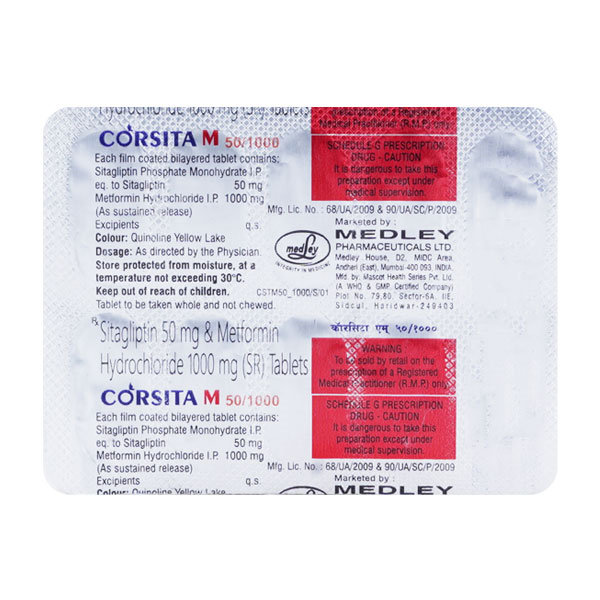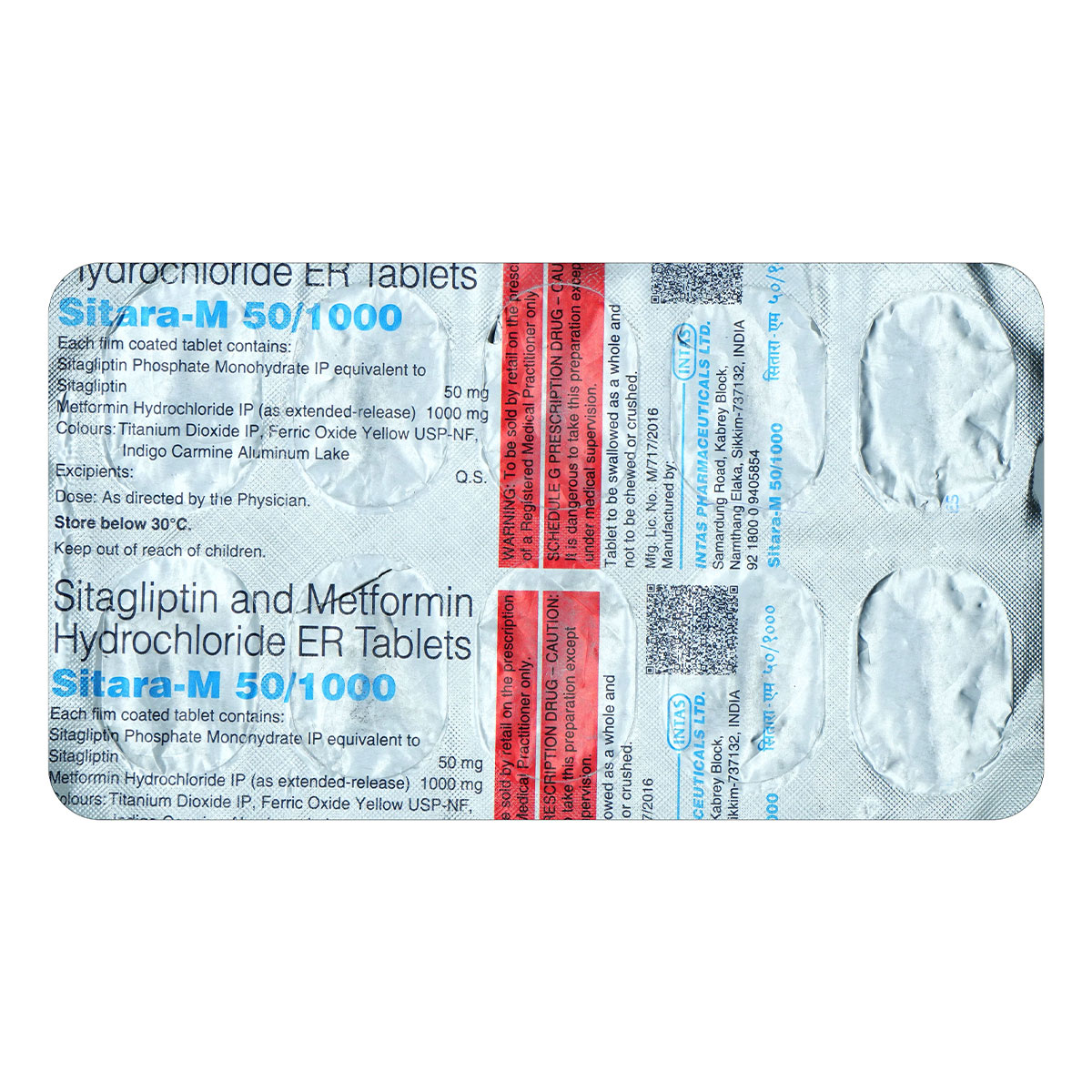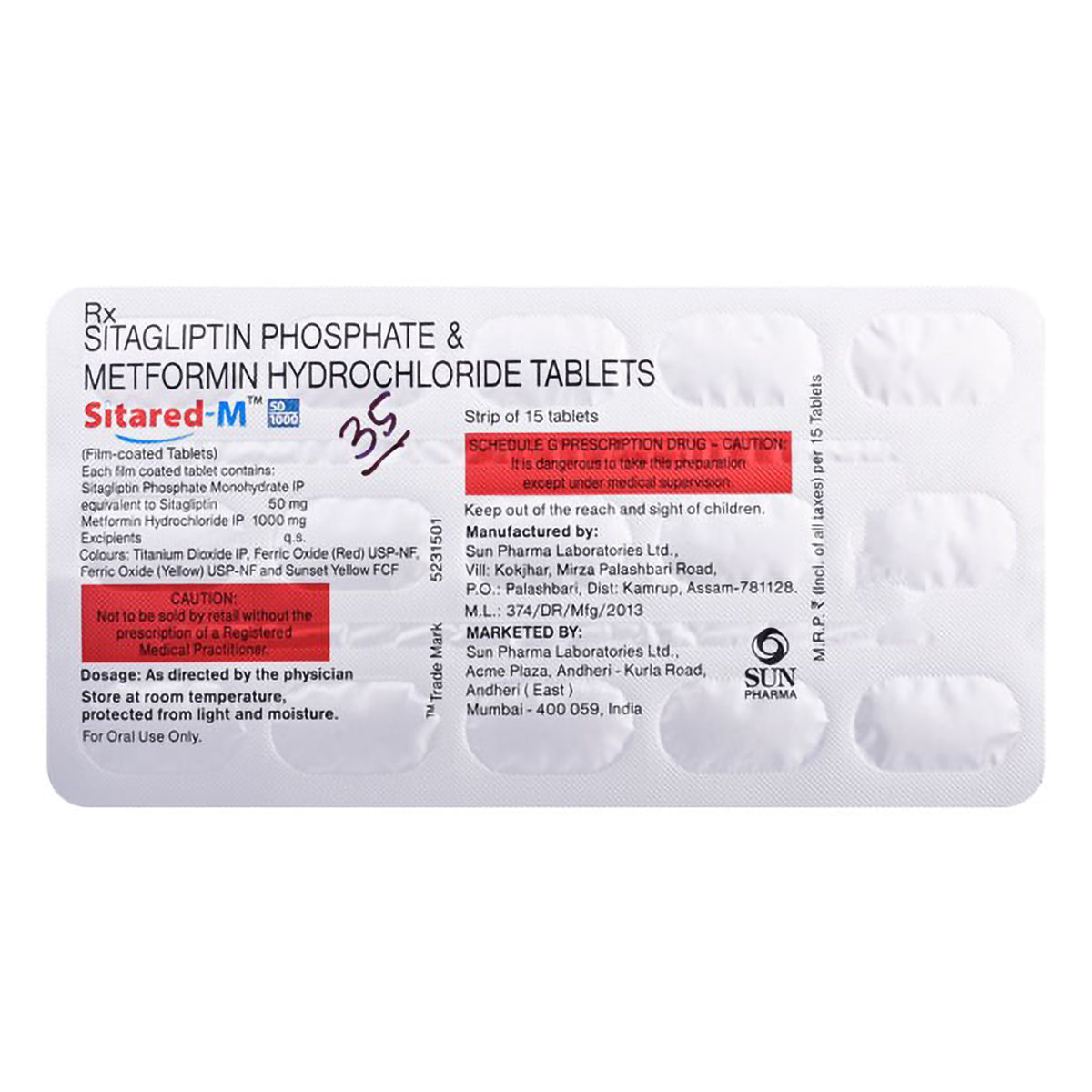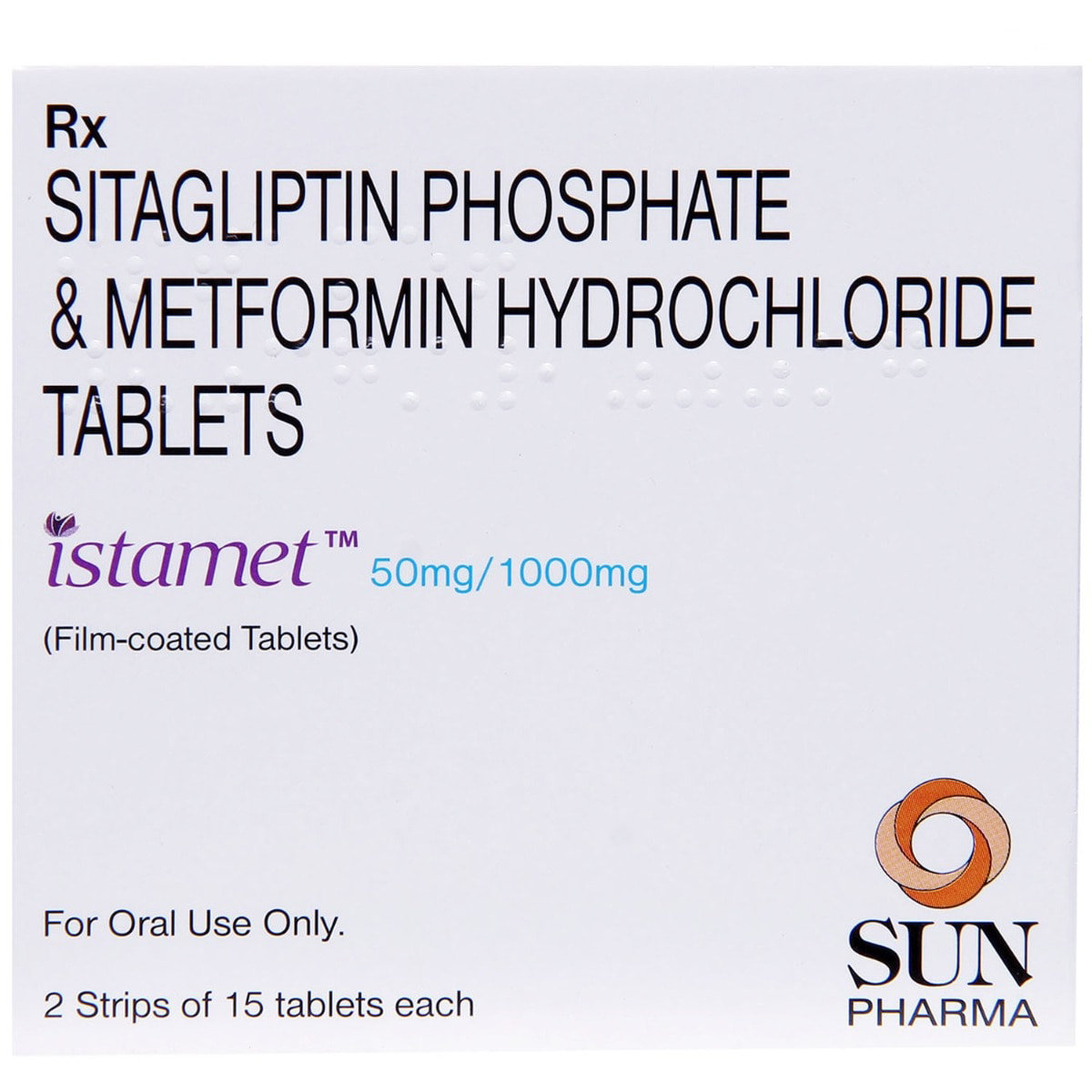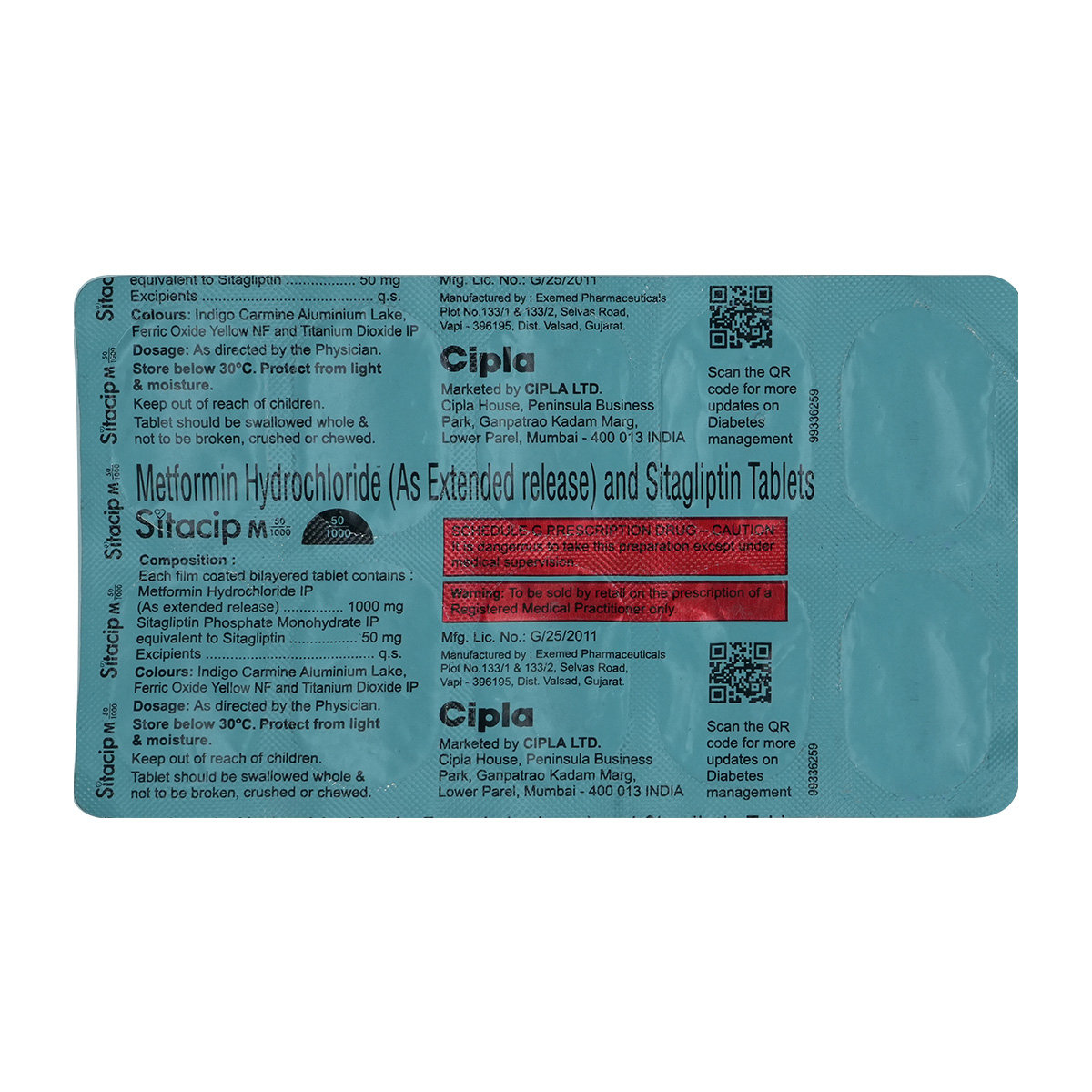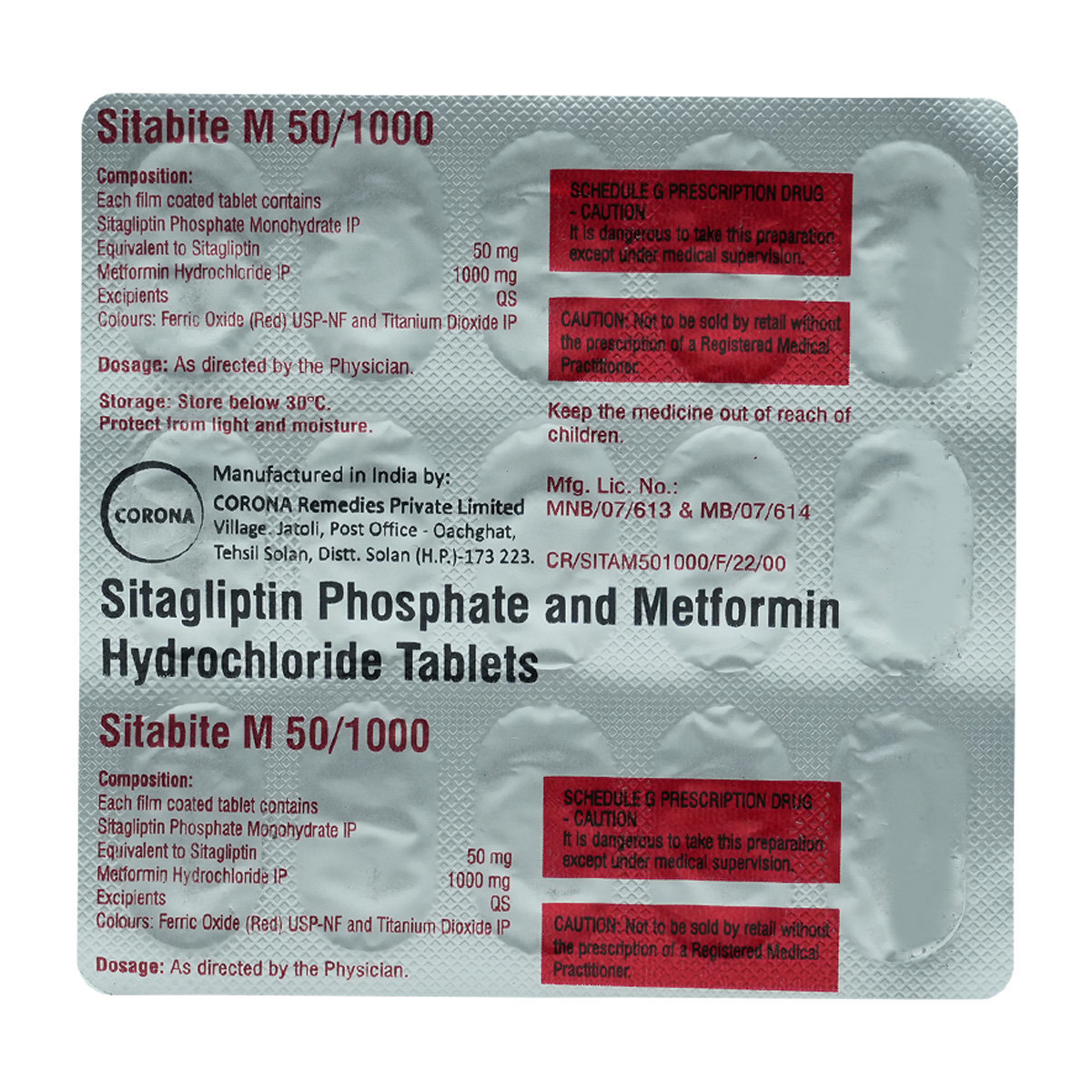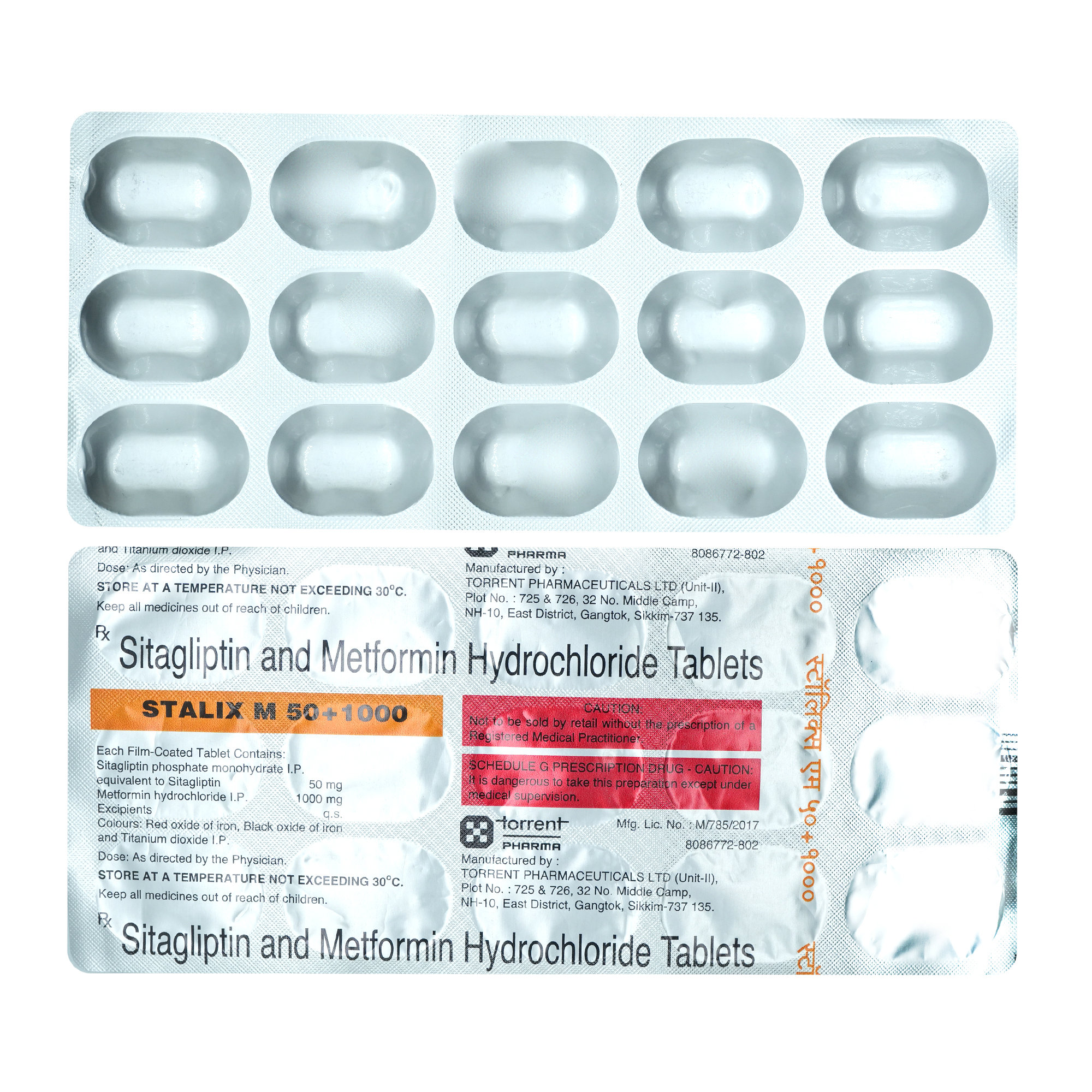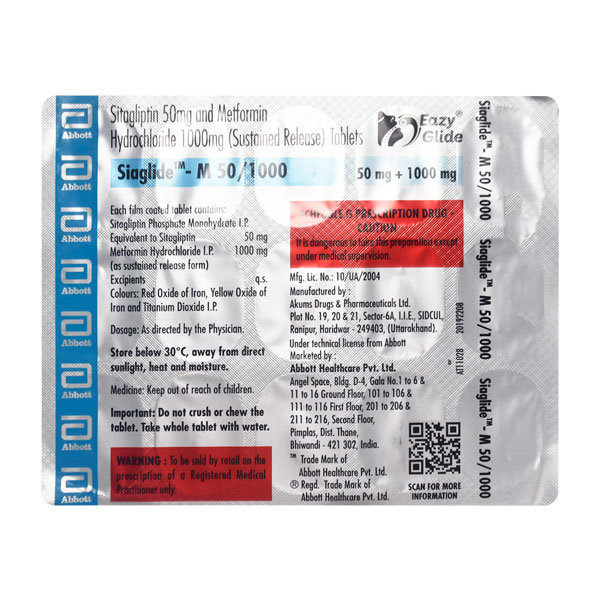Sitaday M 1000 Tablet 15's
Sitaday M 1000 Tablet is a combination drug of Sitagliptin (DPP4 inhibitors) and Metformin (Biguanides) belongs to the class of anti-diabetic. Type 2 diabetes is a condition in which either the body stops producing enough insulin (the hormone which helps to decrease sugar levels in the blood) or there is resistance to the action of insulin. As a result, insulin is produced in large amounts but it is not able to act on the organs of the body.




MRP ₹173
(Inclusive of all Taxes)
₹25.9 Cashback (15%)
Provide Delivery Location
Online payment accepted
 Prescription drug
Prescription drugWhats That
Composition :
Manufacturer/Marketer :
Consume Type :
Return Policy :
Expires on or after :
About Sitaday M 1000 Tablet
Sitaday M 1000 Tablet is a combination drug of Sitagliptin (DPP4 inhibitors) and Metformin (Biguanides) belongs to the class of anti-diabetic. Type 2 diabetes is a condition in which either the body stops producing enough insulin (the hormone which helps to decrease sugar levels in the blood) or there is resistance to the action of insulin. As a result, insulin is produced in large amounts but it is not able to act on the organs of the body.
Sitagliptin belongs to the class of dipeptidyl peptidase-4 (DPP-4) inhibitors which works by increasing the amounts of certain natural substances that lower blood sugar when it is high. Another medicine Metformin belongs to the class of biguanides which lowers glucose production in the liver, delays glucose absorption from intestines and increases the body's sensitivity to insulin. Together, it prevents blood glucose levels from rising to very high levels after meals.
Sitaday M 1000 Tablet should be taken with food to avoid an upset stomach. Sitaday M 1000 Tablet should be taken at the same time of the day each time for best results. For better advice, your doctor will decide, what dose should be taken and it can change timely depending upon your condition. The most common side effect of Sitaday M 1000 Tablet is hypoglycemia (low blood glucose levels) characterised by dizziness, sweating, palpitations, hunger pangs, dry mouth and skin etc. So, to avoid hypoglycemia, you should not miss meals and also should carry some form of sugar along with you. Other side effects include taste change, nausea, diarrhoea, stomach pain, headache, upper respiratory symptoms.
Sitaday M 1000 Tablet should not be stopped even if you feel better, without consulting your doctor as sugar level keeps changing. If you stop taking Sitaday M 1000 Tablet abruptly, it may increase your sugar levels which could further increase the risk of eyesight loss (retinopathy), kidney (nephropathy) and nerve damage (neuropathy). Sitaday M 1000 Tablet should not be taken if you have type 1 diabetes mellitus, severe kidney or liver disease. Please inform your doctor if you have any type of heart disease, is or planning to get pregnant or breastfeeding.
Uses of Sitaday M 1000 Tablet
Directions for Use
Swallow it as a whole with water; do not crush, break or chew it.
Medicinal Benefits
Sitaday M 1000 Tablet helps your pancreas to produce more insulin, make effective utilization of insulin, and decreases excess of sugar that your liver makes. It helps in controlling rise of blood sugar level in your body after meal. Besides this, it does not cause weight gain in the prolonged use. Sitaday M 1000 Tablet plays a vital role in controlling blood sugar levels and prevents serious complications of diabetes like eyesight loss (retinopathy), kidney (nephropathy), nerve damage (neuropathy), diabetic foot ulcer and delayed wound healing.
Storage
- If you experience low blood sugar levels, inform your doctor. They will assess the severity and make recommendations for the next actions.
- Your doctor will assess your symptoms, blood sugar levels, and overall health before recommending the best course of action, which may include treatment, lifestyle modifications, or prescription adjustments.
- Follow your doctor's instructions carefully to manage the episode and adjust your treatment plan.
- Make medication adjustments as recommended by your doctor to prevent future episodes.
- Implement diet and lifestyle modifications as your doctor advises to manage low blood sugar levels.
- Monitor your blood sugar levels closely for patterns and changes.
- Track your progress by recording your blood sugar levels, food intake, and physical activity.
- Seek further guidance from your doctor if symptoms persist or worsen so that your treatment plan can be revised.
- Consult your doctor about alternative medications if side effects occur.
- Ensure adequate intake of food rich in vitamin B12, such as meat, poultry, seafood (salmon and cod), dairy, and eggs.
- Consider a Vitamin B12 supplement, but consult your doctor for the proper dosage.
- Avoid drinking too much alcohol.
- Schedule regular doctor visits to monitor your B12 levels.
- Inform your doctor about the nausea and discuss possible alternatives to the medication or adjustments to the dosage.
- Divide your daily food intake into smaller, more frequent meals to reduce nausea.
- Opt for bland, easily digestible foods like crackers, toast, plain rice, bananas, and applesauce.
- Avoid certain foods that can trigger nausea, such as fatty, greasy, spicy, and smelly foods.
- Drink plenty of fluids, such as water, clear broth, or electrolyte-rich beverages like coconut water or sports drinks.
- Use ginger (tea, ale, or candies) to help relieve nausea.
- Get adequate rest and also avoid strenuous activities that can worsen nausea.
- Talk to your doctor about taking anti-nausea medication if your nausea is severe.
- Record when your nausea occurs, what triggers it, and what provides relief to help you identify patterns and manage your symptoms more effectively.
- Tell your doctor about your GAS symptoms. They may change your medication regimen or prescribe additional drugs to help you manage them.
- To manage GAS symptoms, eat a balanced diet of fibre, vegetables, and fruits.
- Drink enough water throughout the day to avoid constipation and treat GAS symptoms.
- Regular exercise like yoga and walking may help stimulate digestion and alleviate GAS symptoms.
- Take probiotics only if your doctor advises, as they may help alleviate GAS symptoms by promoting gut health.
- Take medication for GAS symptoms only if your doctor advises, as certain medications can interact with your existing prescriptions or worsen symptoms.
- If symptoms persist, worsen, or are accompanied by severe abdominal pain, vomiting, or bleeding, seek immediate medical attention.
- Preventing Vomiting (Before it Happens)
- Take medication exactly as prescribed by your doctor. This can help minimize side effects, including vomiting.
- Having a small meal before taking your medication can help reduce nausea and vomiting.
- Talk to your doctor about taking anti-nausea medication along with your prescribed medication.
- Managing Vomiting (If it Happens)
- Try taking ginger in the form of tea, ale, or candy to help alleviate nausea and vomiting.
- What to Do if Vomiting Persists
- Consult your doctor if vomiting continues or worsens, consult the doctor for guidance on adjusting your medication or additional treatment.
Drug Warnings
Sitaday M 1000 Tablet should not be used in patients with type 1 diabetes or with diabetic ketoacidosis. Some diabetic patients, while taking Sitaday M 1000 Tablet , might develop a rare but serious condition called lactic acidosis. In this condition, too much lactic acid is accumulated in the blood, which can damage the working of your liver and kidney required to eliminate excess lactic acid from the blood. Before you start taking Sitaday M 1000 Tablet , tell your doctor if you’ve ever had pancreatitis (inflammation of the pancreas), kidney disease, and low vitamin B12 levels. Sitaday M 1000 Tablet , when used with insulin, Sitaday M 1000 Tablet may lower the blood sugar level, leading to hypoglycaemia, which can be fatal. In this case, your doctor may adjust the dose by lowering the insulin dose or Sitaday M 1000 Tablet . Prolonged intake of Sitaday M 1000 Tablet may lower your thyroid-stimulating hormone (TSH); hence, an annual check-up of TSH is recommended. In rare cases, you may also develop a serious skin reaction known as bullous pemphigoid that requires immediate medical attention. Tell your doctor if you are going to have a diagnostic test with an injection of dye or X-ray contrast agent. You should stop using Sitaday M 1000 Tablet for a short time before an X-ray procedure.
Drug-Drug Interactions
Drug-Drug Interactions
Login/Sign Up
Co-administration of Sitaday M 1000 Tablet with Gatifloxacin may sometimes affect blood glucose levels. Both high blood glucose and, less frequently, low blood glucose have been reported.
How to manage the interaction:
Taking Sitaday M 1000 Tablet with Gatifloxacin is not recommended as it can lead to a possible interaction, However, it can be taken if advised by the doctor. Consult the prescriber if you experience symptoms such as nervousness, confusion, headache, dizziness, drowsiness, tremors, nausea, hunger, weakness, perspiration, palpitation, rapid heartbeat, increased urination, increased thirst, and increased hunger. Maintaining blood glucose levels is advised. Do not stop using any medications without a doctor's advice.
Co-administration of Iohexol with Sitaday M 1000 Tablet can increase the risk of side effects.
How to manage the interaction:
Taking Sitaday M 1000 Tablet with Iohexol is generally avoided as it can result in an interaction, please consult your doctor before taking it.
Co-administration of Sitaday M 1000 Tablet with Metrizamide together can cause the risk of lactic acidosis (when the body produces too much lactic acid ).
How to manage the interaction:
Taking Sitaday M 1000 Tablet with Metrizamide is generally avoided as it can possibly result in an interaction, it can be taken if a doctor has advised it. However, if you experience headaches, muscle cramps or pain, contact a doctor immediately. Do not discontinue any medications without consulting a doctor.
Co-administration of Iodixanol with Sitaday M 1000 Tablet can increase the risk of side effects.
How to manage the interaction:
Taking Sitaday M 1000 Tablet with Iodixanol is not recommended, please consult a doctor before taking it. Do not discontinue the medications without consulting a doctor.
Co-administration of Iofendylate with Sitaday M 1000 Tablet can increase the risk of side effects.
How to manage the interaction:
Taking Sitaday M 1000 Tablet with Iofendylate is generally avoided as it can result in an interaction, please consult your doctor before taking it.
Co-administration of Iopanoic acid with Sitaday M 1000 Tablet can increase the risk of side effects.
How to manage the interaction:
Taking Sitaday M 1000 Tablet with Iopanoic acid is not recommended, please consult your doctor before taking it.
Co-administration of Ioversol with Sitaday M 1000 Tablet can increase the risk of side effects.
How to manage the interaction:
Taking Sitaday M 1000 Tablet with Ioversol is not recommended, please consult your doctor before taking it.
Co-administration of Sitaday M 1000 Tablet and Iocetamic acid can increase the risk of lactic acidosis (when the body produces too much lactic acid).
How to manage the interaction:
Taking Sitaday M 1000 Tablet with Iocetamic acid is generally avoided as it can result in an interaction, please consult your doctor before taking it.
Co-administration of Iopamidol with Sitaday M 1000 Tablet can increase the risk of side effects.
How to manage the interaction:
Taking Sitaday M 1000 Tablet with Iopamidol is not recommended, please consult a doctor before taking it. Do not discontinue the medications without consulting a doctor.
Co-administration of Sitaday M 1000 Tablet and Iocarmic acid can increase the risk of lactic acidosis (when the body produces too much lactic acid).
How to manage the interaction:
Taking Sitaday M 1000 Tablet with Iocarmic acid is generally avoided as it can result in an interaction. please consult your doctor before taking it.
Drug-Food Interactions
Drug-Food Interactions
Login/Sign Up
Diet & Lifestyle Advise
- Fill your half plate with starchy veggies, a quarter with proteins, and a quarter with whole grain.
- Eat at regular intervals. Do not take a long gap between a meal or snack.
- Monitor your blood sugar level regularly especially when there are lots of fluctuations.
- Invest at least 150 min of moderate-intensity physical activity or one hour and 15 minutes of high-intensity exercise every week.
- Lose weight gradually to achieve a healthy body mass index (18.5 to 24.9).
- Replace refined carbohydrates-containing foods with whole grain foods and increase the intake of fruits and veggies and other fibre-enriched foods.
- Reduce intake of saturated fat (or hidden fats) in food like chips, crisps, pastries, biscuits, and samosas. Choose omega-3 fatty acid-containing oils for daily cooking. For frying, you can use palm oil, mustard oil, groundnut oil, rice bran oil, and safflower oil.
- Do not take stress as it may elevate your blood sugar level. You can adopt stress management techniques like mindfulness to control stress-related blood sugar changes.
- Opt for low-fat dairy products (low-fat yoghurt, fat-free milk, cheese, etc.).
- Keep your blood pressure as normal (140/90) as possible. As it reduces the risk of cardiovascular diseases in diabetes patients.
Side Effects of Sitaday M 1000 Tablet
Low blood sugar
Runny nose
Sore throat
Upper lung infection
Diarrhoea
Nausea
Vomiting
Gas
Stomach upset
Indigestion
General weakness
Headache
Habit Forming
Therapeutic Class
Sitaday M 1000 Tablet Substitute

Sitapride-M 50 mg/1000 mg Tablet 15's
by Others
₹9.21per tabletCorsita M 50 mg/1000 mg Tablet 10's
by Others
₹9.59per tabletSitara-M 50 mg/1000 mg Tablet 10's
by Others
₹10.67per tabletSitared M 50 mg/1000 mg Tablet 15's
by Others
₹10.68per tabletIstamet 50 mg/1000 mg Tablet 15's
by Others
₹10.69per tablet
Product Substitutes
Author Details
We provide you with authentic, trustworthy and relevant information
Drug-Diseases Interactions
Drug-Diseases Interactions
Login/Sign Up
FAQs
Sitagliptin belongs to the class of dipeptidyl peptidase-4 (DPP-4) inhibitors which work by increasing the amounts of certain natural substances that lower blood sugar when it is high. Another medicine Metformin belongs to the class of biguanides which lowers glucose production in the liver, delays glucose absorption from the intestines and increases the body's sensitivity to insulin. Together, it prevents blood glucose levels from rising to very high levels after meals.
If you have symptoms like increased hunger, increased thirst, frequent urination (usually at night), unexplained weight loss, fatigue, blurred vision, slow wound/sores healing, and frequent infections, contact doctor as it can be a condition of type 2 diabetes.
Lactic acidosis is a rare but life-threatening condition when there is too much of lactic acid build up in the bloodstream. Long term intake of Sitaday M 1000 Tablet may lead to lactic acidosis when cells get deprived of the oxygen levels. Symptoms of lactic acidosis include a burning sensation of muscle, muscle ache, fast breathing, nausea, and stomach pain. Immediately contact the doctor in this complication.
In case you feel that your blood sugar level is going down and you are feeling weak, immediately eat sugar candies or drink sugary beverages. It will help to balance the blood sugar level in your body. So, it is advisable to keep sugar candies with you.
Do not take excessive alcohol while taking Sitaday M 1000 Tablet , as this may increase the risk of a life-threatening condition called as lactic acidosis (too much of lactic acid in the body).
No. Sitaday M 1000 Tablet is only prescribed for the treatment of type 2 diabetes also called as 'non-insulin-dependent diabetes'.
Type 2 diabetes is a common form of diabetes in which the blood sugar-lowering hormone called insulin produced by the body does not function properly. Due to this, the blood glucose level increases, and symptoms such as frequent urination, increased thirst, and increased hunger start. Diabetes, if left untreated or not treated properly, can cause long-term complications such as nerve damage, kidney damage, eye damage, foot problems, and also poses a high risk of developing heart diseases.
Drug-Drug Interactions Checker List
- BUPROPION
- CEPHALEXIN
- CIPROFLOXACIN
- CIMETIDINE
- DIGOXIN
- DOLUTEGRAVIR
- GLYCOPYRROLATE
- TOPIRAMATE
- LAMOTRIGINE
- RANOLAZINE
- ALPHA LIPOIC ACID
- ASPIRIN
- PROTHIONAMIDE
- PEGVISOMANT
Disease/Condition Glossary
Type 2 diabetes is a condition where the body is unable to make sufficient insulin, or the insulin that it makes doesn't work properly or utilized by our body. This can cause high blood sugar levels (hyperglycaemia). Symptoms of type 2 diabetes include increased thirst, frequent urination at night, slow wound healing, increased hunger, fatigue, and blurred vision. In some cases, there may be weight gain while in rare cases weight loss may be observed. The complication of type 2 diabetes also includes neuropathy (nerve problems), nephropathy (kidney problems), and retinopathy (damaged retina of eyes or blindness), loss of limbs, sexual dysfunction, and an increase the chance of heart attack or stroke.

Have a query?
Buy best Diabetics products by
Torrent Pharmaceuticals Ltd
Sun Pharmaceutical Industries Ltd
Eris Life Sciences Ltd
Intas Pharmaceuticals Ltd
Lupin Ltd
Micro Labs Ltd
Mankind Pharma Pvt Ltd
Lloyd Healthcare Pvt Ltd
Alkem Laboratories Ltd
Abbott India Ltd
Glenmark Pharmaceuticals Ltd
Cipla Ltd
Macleods Pharmaceuticals Ltd
Wockhardt Ltd
Dr Reddy's Laboratories Ltd
Primus Remedies Pvt Ltd
USV Pvt Ltd
Aristo Pharmaceuticals Pvt Ltd
Emcure Pharmaceuticals Ltd
Alembic Pharmaceuticals Ltd
Ipca Laboratories Ltd
La Renon Healthcare Pvt Ltd
Ajanta Pharma Ltd
Medley Pharmaceuticals Ltd
East West Pharma India Pvt Ltd
Elbrit Life Sciences Pvt Ltd
Corona Remedies Pvt Ltd
Hbc Life Sciences Pvt Ltd
Sinsan Pharmaceuticals Pvt Ltd
Ranmarc Labs
Mitoch Pharma Pvt Ltd
Zydus Healthcare Ltd
Sanofi India Ltd
Akumentis Healthcare Ltd
Fusion Health Care Pvt Ltd
Unison Pharmaceuticals Pvt Ltd
Jubilant Lifesciences Ltd
Novo Nordisk India Pvt Ltd
Tas Med India Pvt Ltd
Blue Cross Laboratories Pvt Ltd
Msn Laboratories Pvt Ltd
Eswar Therapeutics Pvt Ltd
Indoco Remedies Ltd
Q Check Pharmaceuticals
Alteus Biogenics Pvt Ltd
Anthem Bio Pharma
Franco Indian Pharmaceuticals Pvt Ltd
Systopic Laboratories Pvt Ltd
Panacea Biotec Ltd
Zydus Cadila
Biocon Ltd
Edoc Life Sciences Pvt Ltd
Koye Pharmaceuticals Pvt Ltd
Arkas Pharma Pvt Ltd
Diacardus Pharmacy Pvt Ltd
Elinor Pharmaceuticals (P) Ltd
Remedy Life Sciences Pvt Ltd
Saan Labs
Talent India Pvt Ltd
Jarun Pharmaceuticals Pvt Ltd
Capital Pharma
Shrrishti Health Care Products Pvt Ltd
FDC Ltd
Leeford Healthcare Ltd
Nirvana India Pvt Ltd
Elder Pharmaceuticals Ltd
Eli Lilly and Company (India) Pvt Ltd
Glynis Pharmaceuticals Pvt Ltd
Zuventus Healthcare Ltd
Arrient Healthcare Pvt Ltd
Cadomed Pharmaceuticals India Pvt Ltd
Orris Pharmaceuticals
Akesiss Pharma Pvt Ltd
Bal Pharma Ltd
Biochem Pharmaceutical Industries Ltd
Knoll Healthcare Pvt Ltd
Lippon Pharma Pvt Ltd
Morepen Laboratories Ltd
Neucure Lifesciences Pvt Ltd
Opsis Care Lifesciences Pvt Ltd
Wallace Pharmaceuticals Pvt Ltd
Acmedix Pharma Llp
Converge Biotech Pvt Ltd
Erinyle Pharma
Indiabulls Pharmaceuticals Pvt Ltd
Ozone Pharmaceuticals Ltd
Retra Life Science Pvt Ltd
Alvio Pharmaceuticals Pvt Ltd
Geneaid Pharmaceuticals
Heal (India) Laboratories Pvt Ltd
Olcare Laboratories Pvt Ltd
Vasu Organics Pvt Ltd
Kotak Life Sciences
Lakshya Life Sciences Pvt Ltd
Proqol Health Care Pvt Ltd
Sanz Pharmaceuticals
Daylon healthcare pvt Ltd
Mcronus Lifescience Pvt Ltd
Natco Pharma Ltd
Orsim Pharma
Alcohol
Unsafe
It is best to avoid alcohol while taking medication.
Pregnancy
Caution
Sitaday M 1000 Tablet is only recommended during pregnancy when the benefit outweighs the risk. Please consult your doctor before starting Sitaday M 1000 Tablet if you are pregnant or planning to conceive.
Breast Feeding
Caution
Consult your doctor; Sitaday M 1000 Tablet should be used in breastfeeding mothers only if the benefits outweigh the risks.
Driving
Caution
Drive only if you are physically stable and mentally focussed, If you experience drowsiness after taking these medications you should not drive or operate any machinery or vehicles.
Liver
Caution
If you have or had a history or evidence of any liver-related diseases, please consult the doctor before taking medicine.
Kidney
Caution
If you have or had a history or evidence of any kidney-related diseases, please consult the doctor before taking medicine.
Children
Caution
It is advisable to consult a doctor before using it.
Recommended for a 30-day course: 2 Strips



